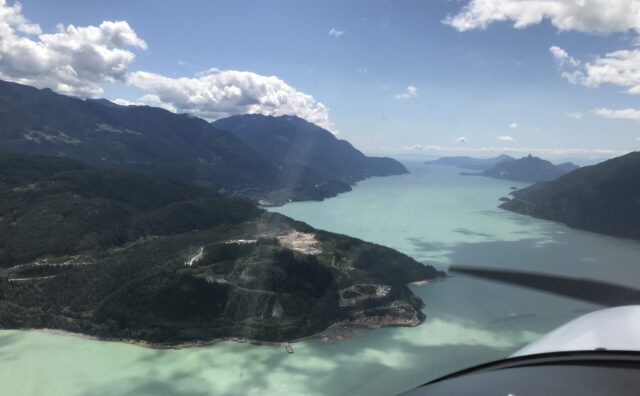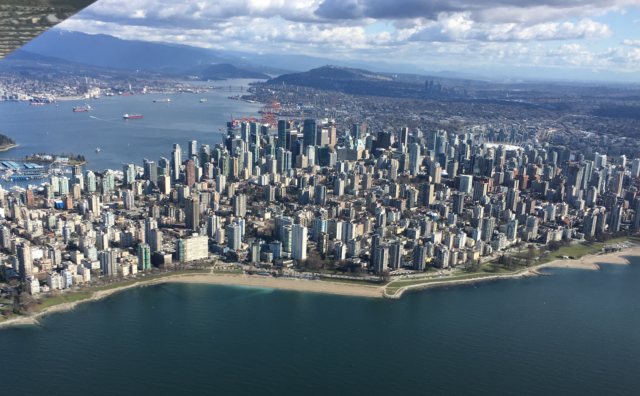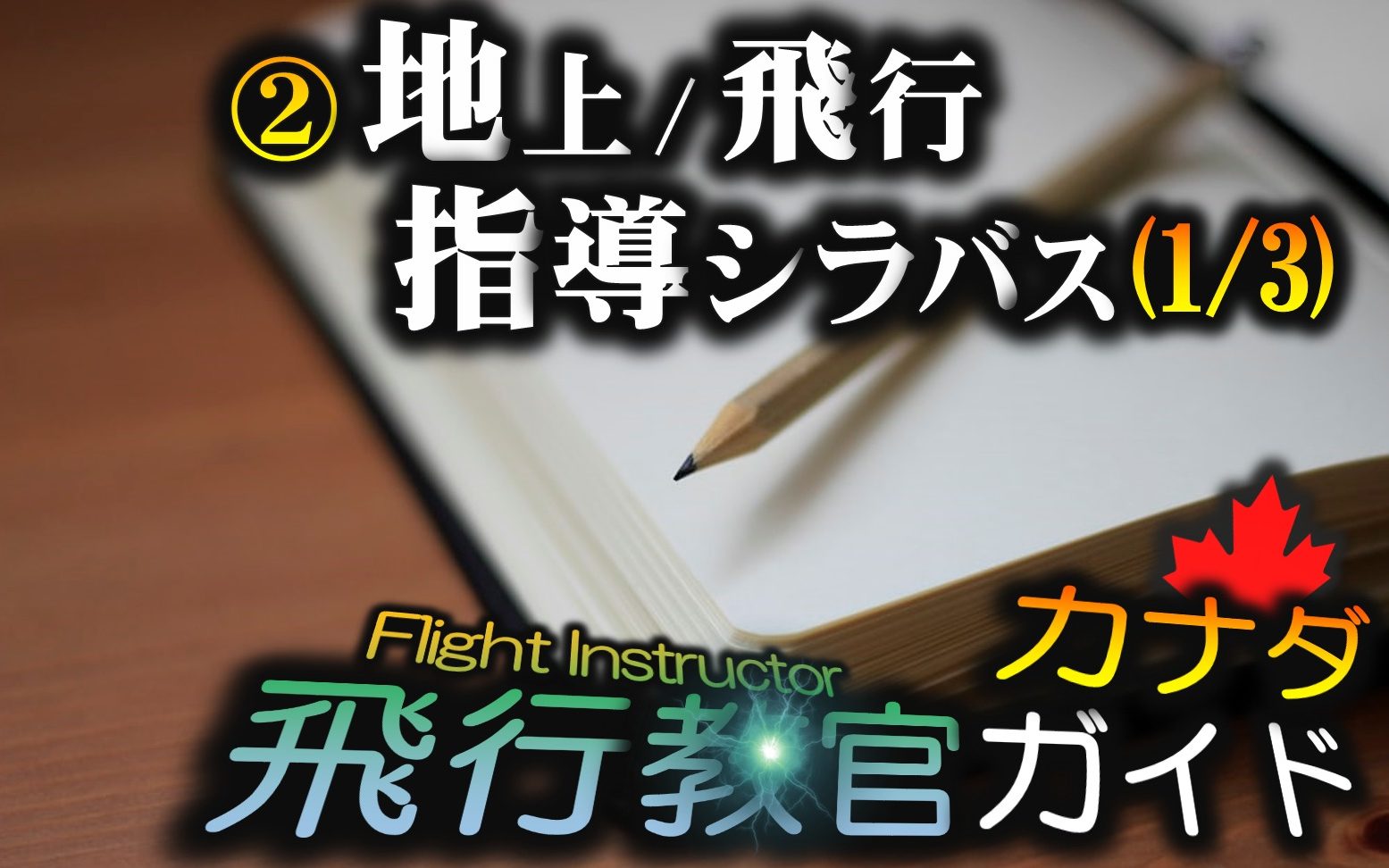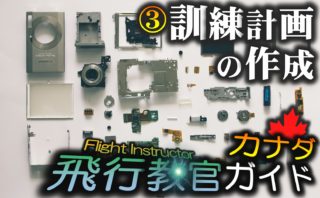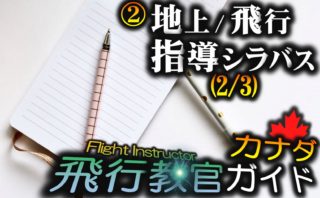第2部 地上/飛行指導シラバス (1/3)
本記事は、4部で構成される飛行教官ガイドの第2部に基づくものです。
第2部は量が多いため、前編(課目1~15)と中編(課目16~23)と後編(課目24~29)に分割しています。
第1部「学習と学習要素」
第2部「地上/飛行指導シラバス」
第3部「訓練計画の作成」
第4部「よくある質問」
はじめに
第2部「地上/飛行指導シラバス」では、経験豊富な飛行教官や飛行教官の訓練生に対し、飛行訓練に関して学生に順序だったプレゼンテーションに向けた方向づけを目的として書かれています。飛行指導法は、使用する機体の種類や搭載している機器の特性に大きく依存するため、それぞれに対する直接的な言及はここではされていません。
この第2部に含まれる資料は、固定脚と固定ピッチプロペラを備えた非常に単純なタイプの機体から、格納式の脚を備えた比較的洗練されたタイプまで、航空機の飛行訓練のすべての側面を包括的にカバーしています。
上空での指導をより効果的なものにするためには、訓練を開始する前に学生が各課目について十分な予備知識を身に付けておくことが不可欠です。
教官がこうした知識を学生に示す際に、訓練補助器材の使用が役立ちます。黒板や模型飛行機、飛行マニュアルなどの基本的な補助用品だけでなく、教官が自ら準備したその他の多くの教材も利用可能です。このガイドやカナダ運輸省の飛行訓練マニュアルと組み合わせて使用することでより効果的となる優れた参考書が市場には多く出回っています。
学生が予備知識を習得する方法は、各科目や個別の訓練機関によって異なります。大規模な学校では、その一部を地上座学担当の教官が教育する場合もありますし、比較的小規模な学校では、それぞれの飛行教官がその教育の責任を負うのが一般的です。
地上指導の範囲や内容によっては、学生にいつ指導すべきかが決まっている場合もあります。地上訓練の計画を短時間で実施できる課目の大部分では、飛行前ブリーフィングと上空指導の直前でこの地上教育を行うことができます。
パイロット航法のように長時間に及ぶ課目の場合には、上空指導を実施する前日など、別に専用の地上座学の時間を設けて教育を行うことがよくあります。このような形で教育を行う場合、教官は飛行前ブリーフィングの際に、その課目に関連する事項を学生がしっかりと理解できていることを確認する必要があります。
第3部にて示される訓練計画を参照すると、教官は個々の課目を他の課目とまとめて訓練計画するような要領についても触れられています。
各課目について
各課目に関して、次の5つのブロックで説明が行われています。
学生による習得が求められる新たな知識や技量に関する詳細。
このガイドは、なぜ学生が特定の技量を学ぶ必要があるのかを説明するものであり、教官は教育指導が重要である理由と、それが学習カリキュラム全体のどこに適合するかを学生が確実に理解できるようにする必要がある。
学生が上空指導で最大の教育効果を得るために必要となる最低限の知識である。
上空指導開始前に、学生が関連する地上教育を完了していることを確認することは教官としての義務の一つである。
特定の指導事項に関して説明したり指導するのに役立つ情報が示される。
学生が上記の目的を達成するため、必要な技量を習得するのに役立つ訓練内容。
課目1:慣熟

- 飛行に関する物理的感覚を学生に紹介すること。
- 必要に応じて実施
- 飛行の目的
- 正式な指導はないが、学生が操縦したい場合には、適したタイミングで機会を与える
- 見張り (学生は視認した他機を指し示す)
- 慣熟飛行に関する学生の質問に回答
- 学生を混乱させるほどの詳細な内容は回避
- これは新たな経験であり、現時点では非常に複雑と思われる要領も継続により容易化することを強調
- この時点でしっかりとした指導は求められないものの、簡単な課目であれば学生に操縦を許可することも可
- この場合、学生を動揺させないよう、乱気流や急激な姿勢変化、急バンク角などはできるだけ避けるべき
- この訓練内容は楽しく行い、学生に達成感を与えるべき
- 短い慣熟飛行を実施
- 興味を引きやすいような識別容易な地形目標物や高度表示、速度表示などについて指摘
課目2:航空機の慣熟と飛行準備

- 適切な文書や機体準備の目的、飛行準備状況の判断法について学生に慣熟させる
- 必要に応じて実施
- パイロット運用ハンドブックを使用し、その目的と概要を説明
- 次の事項について区別し、使用法を説明
- 耐空証明 / 年次耐空証明報告(年次報告) / 登録証明
- 航空機整備記録 (ジャーニーログ) と耐空性の有無の確認
- 重量平衡
- 無線許可証
- 必要に応じ学生に適宜質問
- これを複雑な指導内容としないこと。最終技量水準を初期段階で期待すべきではない。学生は課程進捗に伴って継続的な成長を示すべき。
※ 教官はこの内容が安全飛行を実現する上で最も重要な役割を果たすことを例示
- 実機を使用し主要構成品を識別
- 翼
- 胴体
- 着陸装置
- 尾翼表面
- エルロン / エレベーター / ラダー
- フラップ / トリムタブ
- 次の事項について説明
- 操縦制御と応答
- 補助操縦装置
- 機上計器
- その他の機体システム
- 非常口と装備
- 各機体に応じた乗客安全ブリーフィング法について教示
- 飛行前の機外点検の実施要領とその重要性を説明し強調
- 予定飛行に十分な燃料と潤滑油量の決定 / 各タンクキャップの安全確認
- 機体の消耗品等の点検要領
- エンジン始動時や試運転時のプロペラ後流による損傷を防止するための機体の適切な配置
- チェックリストの適切な使用法について説明
- 次の事項について教示
- コクピットの配置点検
- パーキングブレーキの使用法
- 飛行前点検
- エンジン始動と安全配慮
- エンジン暖気とクリアリング
- エンジン試運転準備完了タイミングの決定法
- 試運転
- 離陸前点検
- ELT点検法と不時発動時の停止法
※ エンジン始動 / 始動後 / 暖気 / 試運転 / 停止要領については、POHを参照
- 次のような状況がある場合には事前注意事項について説明
- 氷上など各種表面での駐機
- ブレーキの過熱
- 機体のタイダウン
- 使用飛行場以外での予定外の着陸に備え、予想されもしくはすでに発生している気象条件に応じて、適切な救命機器 / 救命胴衣や靴の着用または機上搭載する必要があることを説明
課目3:付属装置の操作

- キャブヒート / 混合器 / その他の補助機器操作の目的と操作法を教えること。
- 必要に応じて実施
- キャブレター氷結の原因 / 最も起こり得る温度や湿度の条件を指摘
- キャブレター氷結の症状と早期発見の重要性
- キャブレター高温気システムとそれを使用した除氷や代替空気供給源としての機能
- 寒冷地の運用で、キャブヒート使用により氷の蓄積を誘発する可能性
- 着氷溶融中のエンジン兆候と計器指示
- 蓄積した着氷の完全な除去のための時間の必要性
- キャブレターの気温計の値 / 計測プローブの位置
- POHでの推奨手順を参照し、キャブヒート使用によるキャブレター着氷の予測と防止
- キャブヒートによる燃料/空気混合比への影響とエンジン兆候
- 正しい空燃比の重要性と、温度 / 密度 / 湿度による影響
- 離陸 / 上昇 / 巡航 / 降下の出力設定で正しい混合率を維持するための混合器制御の正しい使用法
- キャブヒート使用時に、混合器制御を使用して正しい空燃比を再確立し、最適なエンジン性能を得る方法
- 風防の防曇装置 / ヒーター / 通気孔の使用
- カウルフラップなど他の装置の使用
- この項目は、付属装置の操作の重要性を強調するため別枠で示されているが、実際には、他の適切な項目と複合した不可欠な内容
- 学生に対し可能な場合に操作を実際に行わせることで最も効率よく学習可能
- キャブレターが着氷する際の形成速度は様々に異なり、除氷に十分な熱がない場合には「回復不可時点」があることを強調する。
そのため学生には着氷状況を頻繁に点検させるよう指導する。
出力変化を伴う課目の訓練中や学生の注意が他の事項に集中している場合に、氷の形成速度が遅いと認識できない可能性がある。 - 極度の寒冷環境下での部分的なキャブヒート使用と、キャブ温度が危険な着氷範囲となるリスクに関する情報について、POHを参照
- 学生は、飛行前にキャブレターでの着氷が形成しやすい条件の存在の有無を確認し、条件が存在する場合にはその深刻度について、定性的な決定を実施
- 次の事項について教示
- 砂塵等の回避のため地上のキャブヒート点検に適したエリア選定
- キャブヒート制御の使用と予想される兆候
- 回転計 / マニホールド圧力の表示に対するキャブヒートの影響
- 円滑なエンジン運転の維持のための混合器制御の正しい使用法
- 低出力設定での長時間降下する場合のエンジンクリアリングの重要性を強調
- 巡航 / 上昇 / 離陸出力を選択する場合
- 適切な巡航高度
- 上昇中
- 降下中
- 必要に応じ他の補助制御の目的と操作法
課目4:地上滑走(タクシー)

- 地上における機体の安全な操縦法
- 必要に応じて実施
- 次の事項について説明
- 飛行場の各種配置 / エプロン / 識別やマーキングを含む誘導路 / 離陸に使用する滑走路や表面 / 滑走路番号やマーキング
- 機体の視認性を高める衝突防止灯と航法灯の使用
- 航空機の隣接物からの適切な間隔確保の必要性 / 地上滑走前の他機との衝突危険性の確認
- 移動開始や停止のための出力使用法
- ステアリング用のブレーキ / 前後輪の使用と尾輪機における方向管制維持のための正しい操作法について説明
- 速度管制に関する考慮事項
- ATIS監視と地上滑走許可の取得法 (標準用語と無線要領の使用)
- 滑走路進入や横断のための管制許可の取得法
- 要求時に地上管制官に機体位置を通報し続ける必要性
- 滑走路の出入域 / 横断 / 停止位置の保持 / 有効滑走路や誘導路前での待機指示の管制許可に対する復唱 (リードバック) または了解確認の義務
- 非管制飛行場における義務周波数と飛行場共通周波数の使用
- 動揺防止のための強風下での飛行制御法
- 地上滑走中の各種飛行計器の点検法
- 空間の制限 / 強風 / 後流の影響回避など各種条件下における駐機に関する考慮事項
- ブレーキ高温時や冬季のパーキングブレーキや車輪止めの使用
- 課目について学生に質問し、必要に応じて明確化
- 機体を過剰速度で地上滑走してはならないことや制御喪失の危険性を強調
- ブレーキの不適切使用は、地上滑走中の最も頻繁なエラーであり、出力の過剰使用がブレーキの過剰や不要な使用が発生
- 強風下での不適切な地上滑走法で多くの事故が発生しており、特に風下側から風上側に旋回する際に、風向に常時注意することを強調
- 強風時や氷結した表面状態などで機体制御維持に不安があれば、支援を得ずに前進しないことを強調
- 次の事項について教示
- 操縦装置に手足を配置
- 障害物や衝突し得る他機の見張り
- 機体の移動を開始、ブレーキを点検
- 該当時は、誘導路と中心線マーキングを使用
- 機体を旋回
尾輪機の場合は、方向制御を維持するための修正操作法と、前方視界を改善するために旋回を利用する方法を指導 - 地上滑走中に飛行計器を点検
- 地上滑走中には飛行制御装置を保持
- 減速し停止
- プロペラ後流の影響に配慮し機体を駐機
- 車輪ブレーキと車輪止めを使用
- 誘導路の使用を妨げないよう試運転場所を選定
課目5:姿勢と運動

- 機体の通常運航における姿勢の範囲
- 所望の飛行姿勢を作り維持するために必要な運動をどう行い制御するか
- ヨーイングとその制御法
- 必要に応じて実施
- 水平線に対する機体の姿勢を定義
- 基準点により巡航姿勢を定義し、次の事項について指摘
- 水平線に対する機首と翼の位置
- 使用出力設定
- この形態における水平飛行速度
- 横軸方向運動 (ピッチング) について
- 基準点の上下による機首上げ/下げ / ピッチ姿勢 / 制限の範囲 / 飛行計器表示について説明
- 機体横軸方向の運動であるピッチングについて定義
- 次の事項について説明
- ピッチング運動はエレベーターによって発生 / 制御
- この運動はピッチ姿勢を確立ために使用
- 姿勢の確立後のエレベーター使用による維持
- 縦軸方向運動 (ローリング) について
- 基準点に対するバンク姿勢 / 制限の範囲 / 飛行計器表示について説明
- 機体縦軸方向の運動であるローリングについて定義
- 次の事項について説明
- ローリング運動はエルロンによって発生 / 制御
- この運動はバンク姿勢を確立するために使用
- バンク姿勢の確立後のエルロン使用による維持
- ピッチとバンク姿勢の組み合わせ / 操縦者と機体に対する運動の関係について説明
- バンク姿勢 / 出力変化 / 横滑り / エルロン抗力 / 乱気流などから生じる力がどうヨーイングを発生させるかを説明し、ラダーで制御できるこのヨーイングの制御が不十分な場合に機体のローリングする可能性について指導
- 見張りを実施
- 衝突に関する幾何学的理論 (正面態勢 / 収束態勢 / 同経路での上昇降下)
- スキャン技術
- 必要に応じ学生に適宜質問
※ 横風離着陸 / 滑り旋回などの状況でのヨー制御については、ガイド後半で解説
- 本項は学生にとって最初の飛行訓練課目のため、全般について最大限注意深く説明すべきであり、今後の飛行訓練課目はすべて本項の基本原則が基盤となるため、強調が必要
- すべての機体姿勢は水平線との位置関係であり、運動は操縦者と機体の関連であることを強調
- すべての運動はゆっくりと姿勢変化を小さく保って行い、学生に問題がないことが明白な場合にのみ運動量を増加
- 完全で継続的な見張りの重要性を強調
- 機体の機首位置をよく参照することを学生に説明し、学生が機首位置を目視できない場合には水平線に対する姿勢の判断ができるような機体前方部分を示して指導
- この課目以降は、教官と学生の間で機体操縦を交替する際の定例要領への準拠が不可欠
- 上空課目を実施する度に操縦上の調和が徐々に達成されることを学生に指導
- エルロン抗力効果に関する指導は、教示 (デモ) が説得力のあるものでない限り、非推奨
- この課目は長々と実施せず簡潔単純で意味のあるものにする
- 巡航姿勢を確立し、参照点を指摘
- 次の事項について教示
- ピッチ姿勢の範囲
- エレベーター使用によるピッチング運動発生と制御
- この運動でピッチ姿勢を所望範囲内として維持する方法
- 学生が適度な技量水準に達したら、飛行計器表示を指摘
- 巡航姿勢を再確立し、参照点を指摘
- 次の事項について教示
- バンク姿勢の範囲
- エルロン使用によるローリング運動発生と制御
- この運動でバンク姿勢を所望範囲内として維持する方法
- 学生が適度な技量水準に達したら、飛行計器表示を指摘
- ピッチとバンク姿勢の組み合わせ
- バンク姿勢でのピッチング、様々なピッチ姿勢でのローリング
- 飛行計器表示を指摘
- ヨーイング運動
- ヨー制御のためラダーをどう使用するかの実際的な実例
- 飛行計器表示
- 本課目の基本原則を適用し、学生に簡単な飛行操作を訓練させる
課目6:水平直線飛行

- 機体の運用速度範囲内における各種速度で水平直線飛行をすること (一定の機首方位 / 選定高度と速度)
- 性能 (パフォーマンス) を達成するための姿勢と出力の組み合わせ
- 必要に応じて実施
- 巡航姿勢
- ヨー制御の必要性
- ヨーイングの原因 (バンク姿勢 / プロペラ後流の効果 / 非対称推力等)
- 特に機首上げ姿勢での飛行中の見張りの必要性を強調
- 直線飛行における考慮事項について説明
- ヨーイング制御-出力変化の影響を減じるラダーの使用法
- 翼を水平に維持する必要性-エルロンの使用法
- 必要に応じトリムの使用法
- 計器表示
- 選定高度を一定に維持しつつ、各種速度での水平飛行に関する考慮事項を説明
- 増速するには (出力増加 / 機首下げ)
- 減速するには (出力減少 / 機首上げ)
- 場周経路内での間隔確保など、巡航速度以外の飛行でこの課目を使用する実例を説明
- 計器表示
- 見張りに関し、衝突の幾何学的理論とスキャン技術を再確認
- 必要に応じ学生に適宜質問
- 水平飛行は一定の高度と速度における飛行として定義され、単に翼を水平線に対し平行に維持することと混同させないこと
- 飛行範囲に関する飛行と飛行耐久 (時間) に対する飛行はそれぞれ別の訓練内容であり、継続して教育し、訓練がその段階に進む際には実際にこの内容を利用して飛行
- 各姿勢の変化の間にトリムの適切な使用について強調
- 機体の調和や慣熟に効果的であり、訓練内容習得のために十分な時間を学生に付与
- この課目は、最大耐久時間速度以下で継続しないこと
- 本課目内で、マグコンパスや方位計を紹介し、以後の課目で復習や訓練を行って、場外飛行訓練前には正確な方位を維持する技量を習得
- 上空の周囲を捜索し、他機を発見する正しい方法について教示
- 水平直線飛行を確立し、目視参照点を指摘
- 速度と回転数を指摘
- 翼を水平に維持しなかった場合の結果を指導
- 出力の増減に伴うヨー制御の必要性を指導
- 計器表示
- 水平直線飛行を確立し、高度を維持する方法を指導
- 通常巡航飛行ーエレベーターの使用法と高度監視
- 選定した低速での飛行-出力と姿勢の関係
- 選定した高速での飛行-出力と姿勢の関係
- 方向管制の監視
- 場周経路内での間隔確保など巡航速度以外の飛行でこの訓練内容を使用する実例について教示
- 計器表示
- 加速 / 減速 / 旋回に関連する問題
- 実用的な使用法
- 直進中にコンパスを利用して方位計を設定する方法
- 安定した気流において
- 荒れた気流において
- 15分ごとに方位計をリセット
課目7:上昇

- 上昇
- 推奨の通常巡航速度での上昇
- 各種速度での巡航上昇
- 推奨の最大上昇率速度での上昇
- 推奨の最大上昇角速度での上昇
- 所望高度でのレベルオフ
- 必要に応じて実施
- POHを使用し、推奨上昇速度をどこで確認できるかについて指導
- 次のような速度の使用について、実用的と定義を実施
- 通常上昇速度
- 最大上昇率上昇速度
- 最大上昇率上昇速度
- 推奨上昇速度以上の速度での上昇「巡航上昇」
- プロペラ後流の効果とヨー制御
- 制御されてないヨーによるロールの発生
- 安全上の考慮事項とコクピット点検
- 水平巡航飛行から上昇に入る手順 (姿勢⇒出力⇒トリム)
- 巡航姿勢に戻る手順 (姿勢⇒出力⇒トリム)
- 地面効果や低速での離陸浮揚直後に上昇に入る際に必要な事前注意事項
- 上昇率に対する密度高度の影響
- 上昇中の適切なエンジン冷却の必要性
- フラップと着陸装置が上昇性能に及ぼす影響
- 上昇におけるキャブヒート使用時の影響
- 上昇性能に対する重量の影響
- 進入復行から上昇に入る手順 (出力⇒姿勢⇒トリム)
- 計器表示
- 必要に応じ学生に適宜質問
- 本課目は漸次的な訓練内容であり、1回の訓練で上昇に関する全方式を指導すべきではなく、最大上昇角/最大上昇率を使用する場合など該当時にのみ教示
- 多くの事故では地面接近時の不十分な上昇要領に原因があり、学生を注意深く監視して定着してしまう前に改善点があれば是正
- 学生が上昇時にしがちな主な誤りの1つに、左方向へのヨーイングを防止するための右翼を下げた保持があり、ラダー使用を強調
- 特に突然の姿勢変化において、習熟が確認されるまでは進入復行から上昇に入る訓練を実施し、フラップを「ゆっくり上げる」正しい方法と、キャブヒートの使用による性能低下を教示
- 効果的に見張りするため、機首方向変更の必要性や長時間上昇中の定期的なわずかな機首下げを強調
- 通常上昇
- 巡航姿勢を確立
- 正面/上方の見張りを実施
- 通常上昇のためのピッチ姿勢を確立、上昇出力を設定
- 目視と計器を使用して直進を維持
- トリム設定
- 必要に応じ選定上昇速度を維持する姿勢に調整、トリム設定
- 選定高度に達したら次の要領で水平直線飛行に復帰
- 機首を下げ巡航姿勢にし増速 (回転数計の赤線超過に注意)
- 直進を保ち高度を維持
- 回転数を巡航出力まで減少
- トリム設定
- 必要に応じ姿勢と出力を調整、選定高度と速度を確立
- 計器表示
- 最大上昇率及び上昇角
- 適切な速度について確認し教示
- 最高上昇率速度
- 最高上昇角速度
- 水平直線飛行に復帰
- 計器表示
- 繰り返し / 指導
- 上昇に対するフラップの影響 (フラップの上げ方とタイミング)
- 該当機の格納式着陸装置の効果
- キャブヒート使用時の上昇性能低下と上昇率の比較
- プロペラ交流効果によりヨーが発生した場合のロールへの影響
- 進入復行 (フラップ / ギア / 補助制御管理) から直進上昇の入り方について教示
- 「巡航上昇」について教示
- 必要に応じ計器表示
課目8:降下

- 推奨パワーオフ降下速度での降下
- 各種出力設定や速度 / 選定高度へのフラップとギア形態での降下
- 特定接地点に向かう一定降下経路での降下
- 障害物を回避する進入における必要な公示速度での降下
- 必要に応じて実施
- 降下速度を決定するためのPOHの使用
- 降下開始後の正面及び下方の適切な見張りの必要性とコクピット点検
- 次のような降下法の実用例
- 各種速度におけるパワーオフ降下
- 各種速度におけるパワーオン降下
- 航続距離に関するパワーオフ降下 / 機体の滑空可能距離の推定法
- 「巡航降下」
- 障害物回避のための降下
- 水平飛行からの降下手順 (出力⇒姿勢⇒トリム) と巡航姿勢への復帰法
- 降下中のフラップ使用
- 失速速度が低下
- 降下角の増大
- プロペラ効果効果の減少によりヨーイングが発生すると、ローリングも発生する可能性
- 滑空距離に対する風の影響
- 一定速度で降下中の出力使用による降下率調整法
- 特に寒冷条件の長時間パワーオフ降下中におけるエンジン暖気の理由と方法
- 各種訓練機で適用可能なパワーオフ降下時のキャブヒート使用
- 高角度降下の速度 / 低速進入の速度
- 格納式着陸装置を展張し、降下を急勾配にする方法
- 各種速度と出力設定による降下中に接地点を発見するための視覚表示
- 該当時の計器表示
- 必要に応じ学生に適宜質問
- 本課目は漸次的な訓練内容であり、1回の訓練で降下に関する全方式を指導すべきではなく、短距離 / 障害物回避進入のためのパワーオン急降下を使用する場合など該当時にのみ教示
- 寒冷地での降下では、エンジン温度維持に特に注意が必要
- 各種速度と出力設定での下降中の接地点発見に役立つ視覚表示の適切な使用法を学生が理解していることを確認
- パワーオフ降下に関する原理や考慮事項について十分な知識を有することは、不時着陸の成功に必要な要素であるため、正しい速度と姿勢を維持する訓練を訓練空域への進出帰投などあらゆる機会を利用して実施し、その時の条件下での機体の滑空性能を推定する訓練を実施
- 降下前後でのキャブヒートや混合器の正しい制御の重要性を強調
- パワーオフ降下に入るには
- 巡航姿勢を確立
- 必要に応じコクピット点検を完了
- 正面 / 下方の見張りを実施
- アイドルまで出力減 / 直進を維持
- 推奨パワーオフ降下速度となるまで巡航姿勢を維持し、機体を適切な降下姿勢に設定
- トリム設定
- 機体の滑空可能距離の判断法 / 速度が距離に与える影響について説明
- 計器表示
- 選定高度 / 速度で巡航飛行に復帰
- 姿勢と出力の変化を調整
- 直進を維持
- 必要に応じキャブヒートをオフ
- 必要に応じ出力 / 姿勢を再調整し、所望の性能を獲得
- トリム設定
- 計器表示
- 次の降下について教示
- 巡航降下
- 出力あり進入
- 計器表示
- 各種フラップ起票時角設定における降下について教示
- フラップ展張 (正確なフラップ展張速度を確認)
- 次の事項について指摘
- フラップを段階的に展張すると、速度維持の場合に降下角が増加
- 巡航姿勢に復帰するためフラップを上げる際の安全上の考慮事項
- 格納式の脚装置がある場合、降下率への影響を教示 (正確な脚下げ速度を確認)
- 障害物を越えるパワーオン降下
- パイロット運用ハンドブックから適切な対気速度を選択
- 姿勢と出力の正しい組み合わせがどう所望の飛行性能を生み出すかを示す
- 所望の形態に適したフラップ設定を実施
- 計器表示
課目9:旋回

- 穏旋回 / 中旋回 / 上昇降下旋回 / 急旋回
- 選定方位への旋回
- 必要に応じて実施
- 衝突に関する幾何学的理論とスキャニング法を確認
- 衝突回避法などの安全上の考慮事項について説明
- 軽訓練機に適用されるバンク角について定義
- 緩旋回 (15°まで)
- 中旋回 (15°から30°)
- 急旋回 (30°以上)
- エルロン抗力に起因するアドバースヨーの制御法を確認
- 次の要領について説明
- 旋回前に効果的な見張りを実施
- 調和のとれた飛行を維持して旋回
- 旋回を維持
- 視覚的な参照を維持しながらバンクとピッチ姿勢を維持
- 旋回中の見張り
- 調和のとれた飛行を維持しつつ復帰
- 上昇下降旋回におけるピッチ姿勢とバンク角の制限の理由
- 次の事項について指摘
- 調和のとれた旋回における各制御の適切な使用
- スパイラルへの不注意な発展を回避するための事前注意
- 急旋回を実施
- バンク角を深めるにつれて揚力増加が必要な理由
- 揚力増加につれて抗力はどう増加するか
- 速度維持のために出力増加が必要な理由
- バンク角が深まる傾向となる理由
- 速度と旋回半径の関係 / 最小旋回半径 / 進入速度 / 出力使用 / フラップ使用
- 回避行動もしくは衝突回避のための急旋回の使用 / 急激な方向転換
- 対向態勢や衝突まで約10秒以内など急旋回が衝突回避に不適切な場合
- 急激なパワーオフ降下旋回中の姿勢 / 速度制御とフラップ使用
- 滑り旋回 (課目15の横滑りを参照)
- 必要に応じ学生に適宜質問
- 飛行中に実例を示しつつ各旋回前後での意味のある見張りの重要性を強調
- 横並び座席式の機体での視覚的基準の違いを強調し、場周飛行で当初から訓練する左旋回を学生が特に好まないようにするため、両方向への旋回訓練が重要
- 旋回における最も起こり得る失敗の1つは、ラダーの過剰使用と不正確使用であり、これは学生が当初からラダーを全く使用しないように指導されている場合には、アドバースヨーの修正以外で発生しないはず
- 精度強調のため、見張りを疎かにしない計器の監視法を学生に指導
- 急激な降下旋回は実際の緊急時にも使用する可能性が高く、低高度での訓練が必要
- 旋回中は、エレベーターで機首姿勢を制御し、ラダーでの機首上げを試みるとスリップが発生することを強調
- 開始前の飛行法が不正確だと誤った旋回に発展することがあり、十分な技量習得までは水平旋回開始前の水平直線飛行を指導
- 学生が上昇降下旋回におけるジャイロ効果とプロペラ後流効果による悪影響を理解し、対策することを確認
- 状況によって上昇または降下旋回中に水平飛行に戻る必要があるが、調和のとれた飛行に向け良い訓練機会となる
- 課目としての急旋回は、荷重負荷を持続する数少ない飛行法の1つであり、操縦者と機体取り扱いによる効果の確認、所望の成果を得るための全翼の制御を調整する訓練機会として、単なる旋回訓練以上の効果がある
学生が検定官の選定する速度で正確にバンク45°の急旋回を実施し、飛行検定で必要な所定高度の維持を実現できるようにするには、かなりの訓練が必要 - 衝突回避のため最後の瞬間で急旋回を実施すると、実際に衝突危険性が高まることと、近距離での正面衝突態勢では垂直方向での回避の方がより効果的であることについてを学生の理解していること確認
運動前後での適切な見張りについて教示し指導
- ヨーイング制御による正しい旋回の開始
- 旋回中の調和のとれた飛行
- ピッチとバンク姿勢制御のための視覚的参照と計器表示
- 復帰 (ロールアウト) とその際のヨーイング制御
- 計器表示
- 次のような追加の考慮事項について指導
- バンク角の増加について教示
- 計器表示
- 旋回中のバンク角増加の傾向について教示し、調和のとれた飛行の必要性を強調
- 計器表示
- 旋回中のバンク角減少の傾向について教示し、調和のとれた飛行の必要性を強調
- 計器表示
- 事前選定した速度と高度を一定に維持するための出力使用
- 出力を増加しない場合の結果と速度損失
- バンクと出力の制限
- 速度と旋回半径の関係 / 最小旋回半径 / 進入速度 / 出力使用 / フラップ使用
- 回避行動または衝突回避のための調整と技法
- 急激なパワーオフ降下旋回中の姿勢と速度管制とフラップ使用
- 計器表示
※ スパイラルへの進展を回避するための姿勢制御の強調と計器監視法
課目10:航続距離と飛行可能時間

- 消費燃料単位あたりの最大距離の飛行
- 消費燃料単位あたりの最長耐空時間の飛行
- 必要に応じて実施
- 範囲を得る飛行
- 最大範囲の飛行 / 実例の列挙
- 検証結果とPOHの表の参照により、範囲飛行の出力設定を確立する方法
- 正面風と背面風での飛行範囲への影響
- 混合器制御の使用
- 高度の影響
- 最大耐久性(飛行時間)を得る飛行
- 最大耐久性を得る飛行 / 高度維持のための最小出力 / 実例の列挙
- 検証結果とPOHの表の参照により、耐久飛行の出力設定を確立する方法
- 混合器制御の使用
- 機体タイプに応じフラップを使用
- 高度の影響
- 必要に応じ学生に適宜質問
- 学生が最大範囲や耐久性を得る飛行に関してPOHで指定される速度や出力設定を決定できることを確認し、範囲を得る飛行において風が実用上考慮すべき追加要因であることを説明
- 検証結果によって最大耐久性を得る飛行の出力設定を確立する方法を指導し、この課目は可能な限り安定した気流条件で実施する必要があるため、トリムの適切な使用が重要
- 最大範囲の飛行
- 巡航飛行から、高度を維持しつつPOHの表から決定された出力に調整
- トリム設定
- 混合器 (ミクスチャ) の適切な使用法について教示
- 計器表示
- 最大耐久性を得るための飛行
- 巡航飛行から、高度を維持しつつPOHから決定された出力に調整
- トリムと混合器の設定
- 巡航状態から水平飛行を維持できる最小設定まで出力を下げる検証結果から得られる速度で飛行する飛行耐久性について教示
- 制御応答の低下に注意
- 計器表示
課目11:低速飛行(スローフライト)

- 低速飛行速度範囲内で飛行しつつ機体を精確に制御するのに必要な適切な飛行法
- 不注意での状態進入を避けるため、低速飛行速度範囲に接近するときの兆候の認識
- 機体の取り扱いに対し調和のとれた飛行を発展させ自信を付与
- 必要に応じて実施
- 「最大の耐久性を得るための飛行」を確認
- 低速飛行を定義し、不整地離陸や不良着陸からの回復など、遭遇する可能性のあるタイミングについて例示
- 酷暑日に重々量状態で離陸直後に旋回を試みるなど、低速飛行に不意に入ることが危険となることについて説明
- コクピットの点検 / 最低高度 / 見張りなど安全上の事前注意事項について指導
- 低速飛行時の考慮事項について説明
- 出力と姿勢の関係 / 高度と方位管制
- 飛行制御の応答の減少
- 制御可能な最小速度の認識
- 水平 / 上昇降下での直線飛行
- 水平で、上昇降下旋回 / バンクとヨーの制御 / 出力の適切な使用 / 上昇降下の制御
- フラップと該当機の着陸装置の効果
- 巡航飛行への復帰
- 必要に応じ学生に適宜質問
- 低速飛行は、最大耐久性を得るための速度より小さく、失速速度よりやや大きい速度範囲内での飛行として定義され、単なる水平飛行だけでなく、この速度範囲での上昇降下、水平飛行や上昇降下中の最大30°バンク角での旋回に習熟する訓練を実施
- 訓練の初期段階では、低速飛行速度範囲の上限での機体制御について訓練
経験を積み習熟するにつれ、巡航 / 離陸 / 着陸の各形態にて調和のとれた旋回をしつつ、失速速度よりわずかに大きい最小操縦速度まで減速する低速飛行法を訓練
操縦自体は可能であるが学生が制御の難しさや制御応答の低下を体感できる程度の速度において、高々度からフラップ完全展張状態着陸時のバウンスからの回復や、負荷条件や密度高度が致命的となる場合での旋回開始など、可能な限り最悪の条件を模擬し訓練 - 方向管制は重要な考慮事項であり、ラダーによりアドバースヨーを制御
- この課目の最初の教示 (デモ) では、対地2,000フィート以上の最低高度が推奨
- 常に見張りをすることの重要性を強調
- 当初は安定した気流条件での実施が理想的で、経験の蓄積に伴い、理想的とは言えない条件でも実施
- 低速飛行の訓練は、実施し忘れるべき操作でなく、低速飛行への不意の進入は失速への接近がほぼ確実であることから、統計上この課目に対するよりよい理解により多くの事故が回避された可能性が示唆される
安全高度において低速飛行速度範囲の致命的となる下限付近速度での飛行など、実際的な上空課目としての教示が重要 - 学生が低速での機体制御を学べるよう、低速飛行を課目として訓練することで飛行「感覚」が発達し、パイロットが危険速度で操縦へ対処が可能
目的の成果実現のため、制御調整や円滑な対処の必要性について強調
- 一定高度における水平 / 上昇降下での直線飛行
- コクピット点検 / 最低高度 / 見張りなど安全上の事前注意事項を完了
- 最大耐久性のために飛行を確立
- 耐久飛行中に操縦の応答を確認
- 低速飛行姿勢を確立
- 対気速度の低下とそれに続く高度低下を指導
- 次の事項について教示
- 高度と選定速度を維持するには、出力の増加と姿勢の調整が必要
- 低速飛行中の応答を制御
- 調和のとれた飛行を実現するためのヨーイングの制御
- 制御可能な最小速度での飛行を含む、低速飛行速度範囲での飛行特性
- 低速飛行速度範囲での上昇降下
- 計器表示
- 水平 / 上昇降下での低速飛行での旋回
- 安全上の事前注意を完了
- 次の事項について教示
- 水平 / 上昇降下での旋回
- 高度 / 上昇降下率を制御するための姿勢と出力の組み合わせの使用
- 飛行計器表示
- 低速飛行の上空課目(1)と(2)を反復し、該当時はフラップと着陸装置の効果について教示
- 巡航飛行への復帰
課目12:失速(ストール)

- 失速への接近時の兆候の認識
- 失速への進入
- 失速自体の認識
- 高度損失を最小限に抑制するための正しい回復法
- 必要に応じて実施
- コクピット点検 / 最低高度 / 適切な場所 / 見張りなど安全上の注意事項について概説
- 失速の基本理論と説明
- 迎え角
- 失速角度
- エルロン抗力
- 各種姿勢
- 各種速度
- 耐久速度と低速飛行による制御応答の低下
- 視覚 / 音 / 感覚による失速への接近兆候
- 失速への接近の防止策
- 上昇降下旋回など通常飛行操作からの典型的な進展
- 出力がある場合とない場合での回復
- ラダーによる方向管制
- 操縦桿を前方に動かして機体の失速からの離脱
- エルロンによる翼の水平
- フラップの影響
- 推力の影響
- 各種失速 (安全高度で実施)
- パワーオン / オフやフラップの有無
- 急激な水平 / 上昇降下旋回とフラップの有無
- 低速時のピッチ姿勢の急激な変化
- フラップの有無にかかわらず最大出力でゆっくり減速する出発時の失速
- 加速失速
- 計器表示
- 必要に応じ学生に適宜質問
- 本課目は漸次的な訓練内容であり、頻繁な訓練が必要
- 典型的な失速のみの指導は避け、学生には、限定空域での着陸復行中の急激な上昇旋回や、密度高度による機体性能の低下など、安全な高度において全飛行段階で失速と回復操作に対応できるよう訓練
- 機体は、実質的にどの速度 / 姿勢 / 出力設定でも失速する可能性があり、兆候を認めてから回復操作を開始することにより、失速防止できることを強調
- シンプルな失速へのエントリーを行う場合は、必要以上に機首を水平線より上げないことを強調し、回復時は機首を水平線より十分下げるだけで、翼を失速から離脱させ高度の過剰損失防止のため出力を使用
- コクピット点検 / 最低高度 / 継続的で効果的な見張り / 市街地の回避など安全上の事前注意を完了
- 耐久飛行と低速飛行の速度範囲による制御応答の減少を確認
- 低速飛行速度範囲の制御可能な最小速度で水平飛行を維持
- 操縦応答 / 視覚的兆候 / 音を確認
- 適切に機首上げし、失速を実施
- 回復操作要領について教示
- 失速と回復操作要領について教示
- パワーオン / オフとフラップの有無
- 急激な水平 / 上昇降下での旋回
- 低速飛行時のピッチ姿勢の急激な変化
- 出発時 / 着陸復行形態について運用安全高度で模擬
- 回復時の急激な姿勢変化による二次失速
- 機体に適用できる修正しないことで高速失速に発展する可能性のある条件について教示
- 計器表示
課目13:旋転(スピン)

- スピンにつながる可能性のある状態の認識と回避
- スピン進入
- 実施すべき正しい回復操作
- 必要に応じて実施
- コクピット点検 / 最低高度 / 適切な空域選定 / 見張りなど安全上の注意事項について指摘
- 初期段階
- 基本原理と説明
- 原因 / 防止法 / 自動回転
- 訓練でのスピン進入法
- 初期段階への進入と完全スピンへの段階変化
- 回復操作
- 推力変化の影響 (高度保持のための初期段階での出力使用 / 失速からの回復との類似点 / 状況継続に伴う影響悪化)
- 計器表示
- 完全スピン段階
- 基本的な理論と説明
- スピン進入 (完全段階への発展原因と防止法 / 初期段階の修正不足)
- 自動回転の完全段階への発展 (初期段階移行)
- 通常 / 緊急の回復操作 (POHで概説される技法使用の必要性)
- 推力の影響 (スピン特性と高度損失)
- 計器表示
- 使用する軽飛行機のスピン特性
- スピン中 / 回復中の方向感覚喪失とその危険性
- 不適切な負荷(G)の危険性 (各重心位置でのスピン回復の効果)
- 必要に応じ学生に適宜質問
- 使用機体がスピン課目の実施を認可されており、適切に搭載負荷管理されていることが不可欠
この要件に違反すると、死傷者発生の可能性
型式証明 / POH / 機内プラカードを参照し、使用機体でのスピン訓練の可否を判断 - 失速~初期段階間の移行段階は、失速~自動回転開始までの期間として定義可
製造社が失速による翼の落下を”拾い上げる”回復法を示していなれば、進展した失速から回復を実施
初期段階におけるすべての状態から正しく回復させる技術は、PPL訓練学生の最も重要な要件の1つ
教官は、学生がこの課目で十分な基準に達していることを確認 - 失速やスピンに起因する事故の多くで死傷者が発生していることから、これらの接近兆候の認識については印象付けられるべきであり、実際の発生には過度な機首上げは不要であることや正しい回復操作について強調
- 訓練でのスピン回復は、対地2,000ft以上もしくは製造社推奨高度のいずれか高い方で完了
- 緊急時のスピン回復法については、出力 / エレベーター / スピン回復できるその他手段の使用について十分に検討
- 不意のスピン発生時のフラップや出力の適切な操作について、学生に注意深く説明
- 訓練での失速やスピンでは、発生のために必要以上に機首位置を水平線以上に上げないこと、移行段階や初期段階からの回復時には、機首を水平線より十分に下げ、翼を失速させずに回復について強調
- ケージできるタイプのジャイロ計器や、スピンによる急激な姿勢変化の影響に耐え得る設計の計器が装備されていないと、課目の実施や訓練で計器損傷の可能性あり
- スピン回復
- 安全上の事前注意を実施 (コクピット点検 / 最低高度 / 適切な空域選定 / 見張り)
- 低速飛行中に失速時点からスピンに移行し、機体の失速中にはヨーイングを継続
- 回復操作について教示
- 移行段階と初期段階の序盤で進展した失速から回復
- スピンへ移行することが許可される場合には、次のいずれかの要領で実施
- POHで推奨の回復操作が記載されてる場合、機体型式や年式に適合する要領を実施
- 回復操作の記載がない場合、次の要領を実施
- 出力アイドル / エルロン中立
- 逆ラダーを一杯まで使用し保持
- 操縦桿を積極的に前方へ動かし、回転停止までこれを保持
- ラダー中立 / 翼水平
- 高度低下を最小限に抑えつつ以後のダイブ降下から徐々に復帰
- 通常飛行に復帰するために必要に応じ出力使用
- 学生訓練を実施
※ フラップ展張状態で機体がスピンに入った場合、回復操作実施後の最初の段階で格納
- スピン開始は次のような要領により教示
- パワーオフ降下
- 上昇飛行
- ラダーを不正確に使用して旋回率を上げ、低速にて降下旋回
- 急激な上昇旋回
- 高G飛行状態 (低速で模擬)
- 進入開始時にスロットルを閉鎖することで、出力使用状態でのスピン進入を教示
- 計器表示
課目14:螺旋降下(スパイラル)

- スパイラル降下につながる可能性のある状況の認識
- スパイラル降下の認識
- 正しい回復操作
- 必要に応じて実施
- コクピット点検 / 最低高度 / 適切な空域選定 / 見張りなど安全上の事前注意事項について指導
- 次の事項について説明
- スパイラル降下の基本理論と説明
- 原因と予防
- スロットルとエルロンの使用による正しい回復操作
- 過剰な速度やG負荷など回復中の注意点
- 計器表示
- 必要に応じ学生に適宜質問
- スパイラル降下は、「機体が過度な機首下げ姿勢となり、対気速度の急激な増加状態における急降下旋回」と定義
- スパイラル降下では、機体の速度制限を急速に超過する可能性があり、関連する危険性や効果的な回復操作法について学生の完全な理解が必要
- 学生はスパイラル降下の兆候やスピンとの相違点について熟知する必要あり
- コクピット点検 / 最低高度 / 見張り / 適切な空域選定などの安全上の事前注意事項を完了
- スパイラルがどう発生し得るかについて教示
- 急旋回中に過剰なバンク角により機首位置が下がりすぎることの放置
- 不完全または不十分なスピンの開始や回復
- 機首上げによりスパイラルがきつくなることを指導し、急激な高度損失や急激な速度増加について注意
- 回復操作について教示
- スロットル閉鎖
- 翼を水平にし調和のとれた制御
- ダイブ降下から脱する
- 計器表示
課目15:すべり飛行(スリップ)

- 開始法 / 実用的使用法 / 横滑りからの回復について指導
- 必要に応じて実施
- 次の事項について説明
- 横滑りの使用
- 余計な高度を減らすため
- 横風着陸技術において
- 滑り旋回において
- 横滑りの開始要領
- 横滑り中の機体姿勢
- ヨーイングとバンクの制御
- 飛行経路の制御
- 回復要領
- 不正確な回復要領の結果
- 計器表示
- 必要に応じ学生に適宜質問
- 横滑りや滑り旋回は、学生が操縦法を十分理解するまでは高度をとり教示し訓練させ、その後に実場面に適用して行う教示では、地面近くで実施
- 一部の機体では、ピトー管と静圧孔の位置により、速度の測定値がスリップ方向によって信頼性が低下するため、左右のスリップで同じ姿勢を使用することを強調
- 降下率を上げるために横滑りを使用して着陸進入を実施する際は、横滑りを常に風上側に向けて実施
- よくある失敗としては、通常飛行に復帰する際の速度低下であり、これにより多くの場合、ハードな着陸となるため、正しい降下姿勢に復帰するためには、安全高度で機首をわずかに下げる必要があることを強調し、通常の進入を継続
- 現代のほとんどの機体において、中程度のバンク角での横滑りでは方向維持が困難であり、特にフラップ不使用で実施する不時着陸では、滑り旋回の実施が特に重要
- コクピット点検 / 最低高度 / 見張りなど完全上の事前注意事項の完了
- パワーオフ降下からの滑り旋回への進入を教示 (バンク実施 / ヨー制御 / 正しい姿勢維持)
- 次の事項について教示
- 対地航跡
- 各種降下率
- 回復法
- 翼水平 / ヨー制御 / 正確な速度への姿勢調整
- 横風進入や着陸時の偏流修正の際の横滑りの使用法について指導
- 滑り旋回
- ヨーイングの調整
- 進入と回復中の姿勢制御
- 実用的な使用法
- ピトー管と静圧孔の配置によっては、対気速度計が横滑り時に信頼できない可能性があることを指導
- 計器表示
続きは②(2/3)へ

